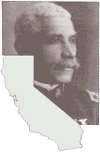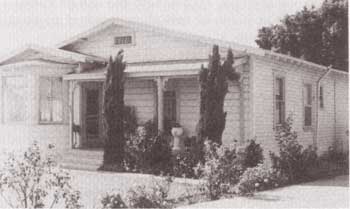![]()

Five Views: An Ethnic Historic Site Survey for California
MENU
Introduction
A.M.E. Church
Education
Industry
Farming
Business
Associations
Noted Individuals
Historic Sites
Selected References

A History of Black Americans in California:
HISTORIC SITES
Colored School
Watsonville, Santa Cruz County
The Colored School in Watsonville, Santa Cruz County, was located in a small, unassuming cottage set back from the street on a deep lot. The exterior does not seem to have been altered, and it has the original clapboard siding.
This small building was the Pajaro Valley School District's response to Robert Johnson, a Black farmer from Tennessee who asked to have his children admitted to the public school. Rather than permitting Black children to attend the same school as their White peers, the district in 1864 hired a woman to teach Blacks in her home. Again, in 1866, Johnson requested that his children be admitted to the public school on the "grounds he was taxed for the support of the school and, under the provision of the Civil Rights Bill his children were entitled to the benefits of the School." (Pajaro Times, September 15, 1866) In response, the school trustees raised money to build "A Colored School." Johnson contributed the site for the school; however, certain conditions were stipulated to ensure continued use of the land for non-segregated education purposes. On October 29, 1866, Robert Johnson conveyed title to the property on East Lake Street to the Pajaro Valley School District, with the following stipulations: the land, he stated, was "to be used for a schoolhouse to which children shall be admitted irrespective of color for the purpose of education, who shall have arrived at legal school age, and demean themselves accordingly to the rules and customs of common school . . . and should this school not be maintained for any year in time of peace, then this instrument shall be void and the land and promises herein described shall revert to said party of the first part, his heirs, executor, administrator and assigns." (recorded November 5, 1866, Deed Book 8) By 1878, the Black community had moved to end the separate-but-equal education policy, but the trustees denied their petition. Blacks then boycotted the "Colored School." In retaliation, the trustees closed the school, and Johnson filed suit to bring a test case to court. In July 1879, the trustees agreed to abolish the traditional policy of separate-but-equal education, a decision possibly prompted by the fact that the site of the closed school would revert to Johnson as stipulated by the deed.
Today, the small 1866 Colored School still stands on the Johnson lot, but the property no longer serves its intended use. The building is now a private home.

Colored School, Watsonville, Santa Cruz County
NEXT> Daniel Scott's School
Last Modified: Wed, Nov 17 2004 10:00:00 pm PDT
http://www.cr.nps.gov/history/online_books/5views/5views2h31.htm
![]()
 Top
Top